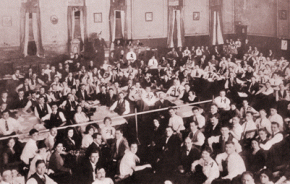A communist party in the U.S.
1919 saw the formation of communist parties throughout the world--the culmination of a process that began with the outbreak of the First World War in 1914, the capitulation of most of the major socialist parties to patriotism, and the success of the Bolshevik Revolution in Russia in 1917. traces the formation of the Communist Party in the U.S. and assesses its impact on American politics.
IN COUNTRIES like Germany and Italy, the communist parties began as small parties but quickly grew in the early 1920s into mass parties claiming the allegiance of hundreds of thousands of workers.
The U.S. Communist Party (CP)--formed out of the expelled left wing of the Socialist Party (SP) in 1919--did not experience a similar take-off. It was beset by difficulties from the start--problems reflecting both the political weaknesses of the SP left, a strong post-war economic boom and massive political repression.
The prospects for the development of a communist party of substantial size and influence were quite real in 1919. The SP numbered over 100,000. Inspired by the Bolshevik Revolution, the majority of the SP rank and file moved rapidly to the left. In the spring of 1919, 12 of the 15 seats on the National Executive Committee went to the left wing.
Louis Fraina, editor of the left wing's Revolutionary Age, which brought to the U.S. working class a systematic exposition of Marxist ideas and an analysis of the Russian Revolution, was in 1919 the most popular leader in the party. John Reed, author of the now-classic Ten Days that Shook the World, a stirring first-hand account of the revolution, was probably a close second.

That the right wing felt compelled to expel two-thirds of the party's membership in order to cleanse it of its left wing was further proof of the left's influence.
But the high degree of support for the left wing obscured the fact that it was divided in a number of ways that were to prove disastrous.
Immediately after the expulsions, a split developed over how the left should respond: Make an attempt to take the reins of the SP leadership and expel the right-wing usurpers or immediately declare the formation of a new communist party?
Moreover, this division was underscored by another, more serious split between the foreign-language federations and the native-born and English-speaking foreign-born leftists.
A hastily convened conference of the left wing was called in he summer of 1919 and narrowly voted for "capturing the Socialist Party for revolutionary socialism." The Michigan delegates and most of the foreign-language federation delegates, who favored the immediate formation of a communist party, walked out in protest.
Within weeks, a majority of left-wing leaders, including Fraina and Charles Ruthenberg, gave in to the demand to immediately form a new communist party. A smaller group headed by John Reed and Benjamin Gitlow remained determined to attend the special SP convention on August 30 in Chicago and attempt to retake the party.
THE MAJORITY of the left wing, and in particular the Russian federation, tended to interpret the experience of the Bolsheviks in a wooden manner. This was reflected in the debate over whether to immediately form a new party.
A tactical debate over how long to remain within the SP to win over the greatest number of workers was transformed into a debate over principle: since the founding declaration of the Communist International urged the "formation of independent communist parties," any attempt to remain within the SP represented "opportunism."
With the aid of the Chicago police, the Reed-Gitlow group was expelled from the SP conference. But instead of moving over to the founding meeting of the majority group in order to fuse into one party, they met separately.
So on August 30, two communist parties were formed--the larger formation calling itself the Communist Party (CP), consisting of the foreign-language federation (Russians, Poles, Lithuanians, Lettish, Ukrainians, etc.), and a smaller group of English-speaking socialists--the smaller group calling itself the Communist Labor Party (CLP).
The inability of the left wing to unite and win over a significant number of sympathizers in the SP proved a serious mistake. Out of something like 70,000 left sympathizers in the SP, the two newly formed parties were able to win at most just over half that.
At their founding, the combined membership of the two organizations was somewhere between 25,000 and 40,000, probably closer to the former figure. Some leftists who were not yet prepared to leave the SP were left behind, while many more simply fell through the cracks, dropping out of party life.
The two parties were virtually identical in basic program. Both recognized the Communist International, and both advocated the revolutionary conquest of power by the working class and rejected "parliamentarianism."
Both also reflected the sectarian and syndicalist weaknesses of the American left--advocating the destruction of the American Federation of Labor (AFL), the creation of "revolutionary unions" and the rejection of any orientation to elections (to the point where they refused to endorse Eugene Debs when he ran for president in 1920).
The sectarianism of both sides made reconciliation extremely difficult. The CLP should only accept the admission of CP members as individuals--arguing that the foreign-language federations, considered out of touch with American conditions, could not be allowed to dominate the movement.
In their counterposing of "American" and "foreigner," CLP leaders like Reed and Gitlow came dangerously close to chauvinism.
The foreign-language federations, for their part, tended to behave as autonomous units, each with its own newspaper and leaders.
In spite of their clam to represent "Bolshevism" in the U.S., they did not see the necessity of building a party that united workers of all races and nationalities together in a centralized party--as the Bolsheviks had done in Russian.
Instead, they clung to a federalist method of organization the divided workers according to their language.
Moreover, both parties took a sectarian all-or-nothing attitude to the class struggle. Anything short of the revolutionary onslaught--which was seen as imminent in the U.S.--was disdained as an opportunist compromise with the system.
For example, in the 1919 Great Steel Strike, which drew 365,000 workers out for union recognition, the communists made no attempt to relate their slogans to what was possible under existing conditions.
The strike, defensive in character and ineptly led by the AFL bureaucracy, was defeated after a massive campaign of repression and scabbing. With no base in the AFL, the communists were not in the best position to relate to the strike. But they offered no concrete arguments that connected with the issues of the strike.
Instead, the CP's The Communist advocated using the steel strike to "develop the general political strike that will break the power of capitalism and initiate the dictatorship of the proletariat," an outlook widely out of step with the level of class consciousness in the working class at the time.
The communists' ultra-leftism prevented them from bridging the gap between the day-to- day concerns over wages and conditions of U.S. workers, whether foreign or native-born, and the task of building a revolutionary party.
The problem was not to "Americanize" the movement so much as to build a centralized party that was willing to go to the working class--in the trade unions, the SP and the Industrial Workers of the World--and find ways to connect the daily struggles of workers to the aim of revolutionary socialism.
But the political and organizational problems that beset the new communist movement were not its only obstacle. 1919 witnessed one of the biggest labor upsurges in U.S. history. The Seattle General Strike, the Boston police strike and the steel strike all occurred in 1919.
BARELY FORMED and still tied up in sectarian wrangles, the communists were unable to take advantage of these struggles. Moreover, most of these struggles ended in defeat and were followed by a wave of savage repression against the left, which had a devastating effect.
Mass arrests, deportations, beatings and outright murder decimated the ranks of he communists and drove them temporarily underground.
The Palmer Raids, named after then-Attorney General A. Mitchell Palmer, the architect of the crackdown, depleted the parties' ranks. The combined membership of both parties declined from about 50,000 to about 10,000 by January of 1920--a figure that was then cut in half in the net two years of underground existence.
On an order from the Comintern, the two new parties merged in 1920. But this was not the end of the CP's problems. The isolation produced by underground existence helped to fuel the party's sectarian tendencies.
The party's rhetoric became ultra-revolutionary, but it connected to no one. As James P. Cannon, a founder-member of the party, said:
It seems to be a peculiar law that the greater a party's isolation from the living labor movement, the less contact it has with the mass movement, and the less correction it can get from the impact of the mass movement, all the more radical it becomes in its formulations...
It didn't cost any more to be extra-radical because nobody paid any attention anyhow. We didn't have public meetings; we didn't have to talk to workers or see what their reactions were to our slogans.
Once again the fetish to do everything exactly as the Bolsheviks had done it led many leading communists to make a virtue of underground, illegal activity.
When the fog of repression lifted and it became possible again to hold public meetings, to distribute literature unharassed, etc., the bulk of the party leadership remained committed in principle to maintaining an illegal party apparatus.
It based this argument on the grounds that the Bolsheviks in Russian always opposed the "liquidation" of the illegal apparatus into a legal one, since in Russian conditions it was impossible to have a legal party with revolutionary politics.
But this was to transplant methods necessary for operating in a police state to a bourgeois democracy. The effect was to unnecessarily prolong for isolation of the parties from the working class, preventing them from effectively utilizing the legal channels available in the U.S.
There were a number of leading communists, among them Cannon--later to be a founder of the Trotskyist movement in the U.S.--who understood the problems facing the CP and sought ways to overcome them.
Sadly, at the very time the party was beginning to grapple with its problems, it was falling victim to the rise of Stalinism in Russia and the bureaucratic degeneration of the Communist International.
Despite the problems faced and errors made by the earlier communist movement, we can agree with Cannon that:
it was composed of thousands of courageous and devoted revolutionaries willing to make sacrifices and take risks for the movement.
In spite of all their mistakes, they built a party the like of which this country has never seen before; that is, a party founded on a Marxist program, with a professional leadership and disciplined ranks.
This article originally appeared in Socialist Worker in November 1989.


